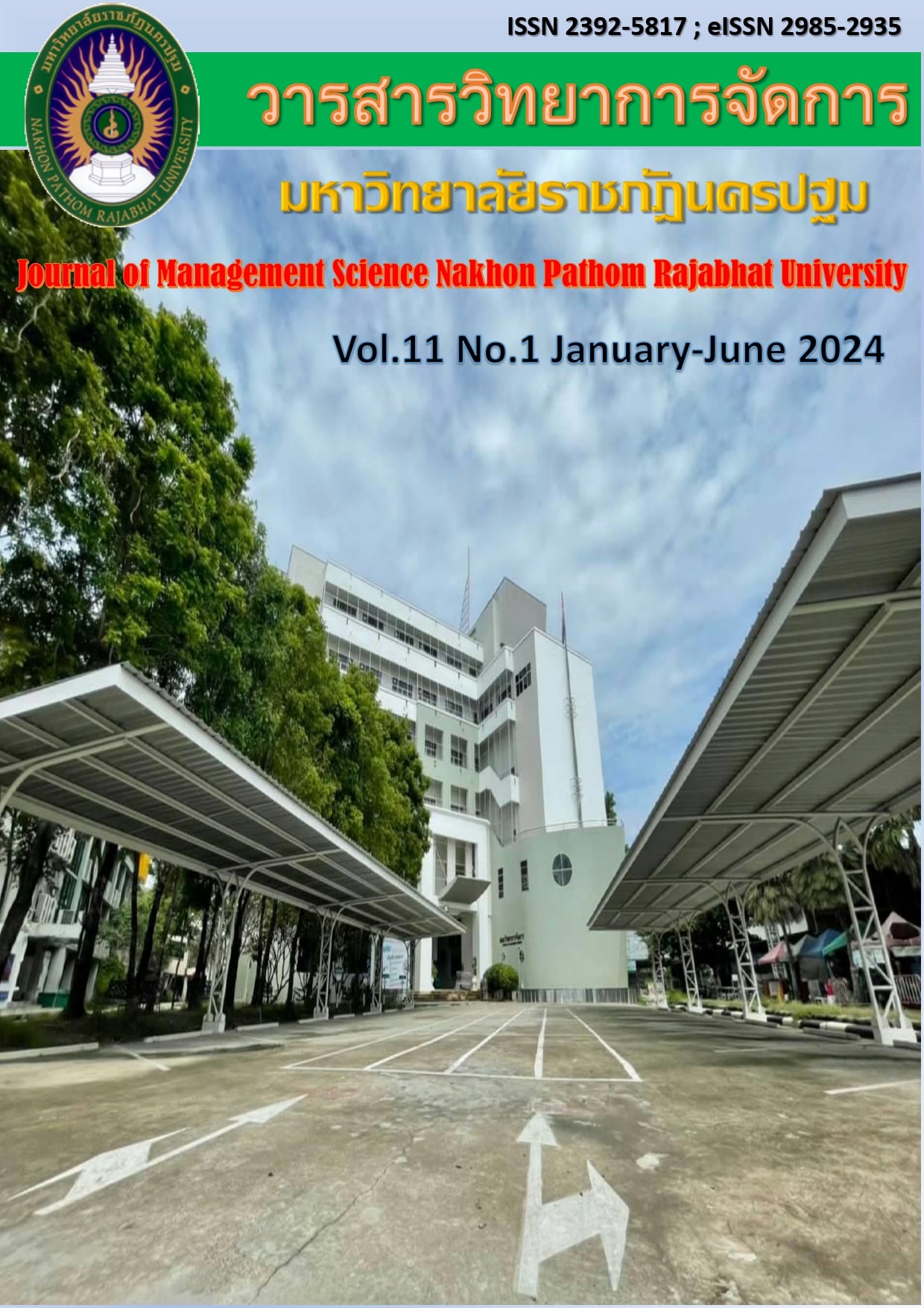Effectiveness of the Rapid Transit System management of the Yellow Line in Bangkok Metropolis and its Perimeter
Main Article Content
Abstract
Research results (1) Conditions of management of the Yellow Line rapid transit system in Bangkok and surrounding areas. It was found that the government sector has organized other forms of public transportation that are conveniently connected to the mass transit. Can accommodate tourists with fast and convenient public transportation. It plays an important role that affects people's daily lives causing a change in travel patterns. The private sector has expanded investment in land development along the electric train lines and nearby areas causing the expansion of new communities Especially residential real estate projects Economic activities continued to increase. Consumers are more likely to adjust their behavior to use electric train services especially the middle class with purchasing power who wants convenience and speed in traveling and certainty of time. All groups of people can access services. Responding to the hustle and bustle of today's society. (2) The effectiveness of the management of the Yellow Line rapid transit system in Bangkok and surrounding areas was found to be a fast and convenient public transport service, It is safe. Respond to the needs of the people in daily life is very clean, safe, pollution-free, resulting in a change in travel patterns Reduce inequality in urban areas around Bangkok and surrounding areas and (3) guidelines for managing the rapid transit system of the Yellow Line in Bangkok and surrounding areas. In order to achieve the specified goals. Therefore, a clear operational policy framework must be established. Introducing technology systems to monitor, follow up or receive various complaints. Moving forward to raise the level of service to facilitate and connect travel for citizens who want to access the rail transportation system as well as responding to the use of services Innovative modern technology is used to supervise the rail transport system to meet standards and safety.
Article history: Received 16 January 2024
Revised 27 March 2024
Accepted 28 March 2024
SIMILARITY INDEX = 5.46 %
Article Details

This work is licensed under a Creative Commons Attribution-NonCommercial-NoDerivatives 4.0 International License.
The views and opinions of the article appearing in this journal are those of the author. It is not considered a view and responsibility of the editorial staff.
References
กระทรวงคมนาคม. (2564). รายงานประจำปี 2564. กรุงเทพฯ: กระทรวงคมนาคม.
นราธิป ศรีราม. (2557). แนวคิดเกี่ยวกับการจัดบริการสาธารณะของท้องถิ่น”, เอกสารการสอนชุดวิชาการจัดบริการสาธารณะของท้องถิ่น หน่วยที่ 1-7, นนทบุรี: สำนักพิมพ์มหาวิทยาลัยสุโขทัยธรรมาธิราช.
นันทวัฒน์ บรมานันท์. (2554). มาตรฐานใหม่ของการจัดทำบริการสาธารณะระดับชาติในประเทศไทย. กรุงเทพฯ : วิญญูชน.
ภานุพงศ์ รัชธร, ปธานิน บุตตะมาศ. (2564). การศึกษาความเหลื่อมล้ำด้านการเข้าถึงระบบขนส่งสาธารณะใน กรุงเทพมหานคร และปริมณฑล. วารสารการขนส่งและโลจิสติกส์, 13(1), 41-62.
ภาวิณี เอี่ยมตระกูล, ไอศูรย์ เรืองรัตนอัมพร และ ภัททิยา ชินพิริยะ. (2560). กรอบการวิเคราะห์นโยบายการ
วางแผนการพัฒนาพื้นที่บริเวณรอบสถานีขนส่งมวลชนเพื่อการพัฒนาเมืองอย่างยั่งยืน. วารสารวิจัยและ สาระสถาปัตยกรรม/การผังเมือง, 14(1), 95-122.
สภาขับเคลื่อนการปฎิรูปประเทศ. (2559). ข้อเสนอแนะเพื่อการขับเคลื่อนการปฏิรูปประเทศตามมาตรา 31 ของรัฐธรรมนูญแห่งราชอาณาจักรไทย เรื่องการแก้ปัญหาการจราจรในเมืองใหญ่. การประชุมสภาขับเคลื่อนการปฎิรูปประเทศ ครั้งที่ 46/2559 วันจันทร์ที่ 12 กันยายน 2559.
สุรชัย พรมปากดี. (2565). ปัจจัยทางการบริหารที่ส่งผลต่อประสิทธิผลการบริหารงานโรงเรียน สังกัดสำนักงานเขตพื้นที่การศึกษามัธยมศึกษานครพนม. วิทยานิพนธ์ครุศาสตรมหาบัณฑิต สาขาวิชาการบริหารการศึกษา มหาวิทยาลัยราชภัฏสกลนคร.
สำนักงานนโยบายและแผนการขนส่งและจราจรและการรถไฟฟ้าขนส่งมวลชนแห่งประเทศไทย. (2564). รายงานโครงสร้างพื้นฐานคมนาคม ประจำปีพ.ศ. 2564. [ออนไลน์] ค้นเมื่อ 22 ตุลาคม 2566 จาก https://www.otp.go.th/uploads/tiny_ uploads /PDF/2565-10/25651011-TransportInfrastructureAnnualReport2021.pdf
อรทัย ก๊กผล. (2552). เคล็ดลับการจัดบริการสาธารณะท้องถิ่น: บทเรียนจากรางวัลพระปกเกล้า’ 51, กรุงเทพฯ: บริษัท ส เจริญ การพิมพ์ จำกัด.
อัจฉรา ลิ้มมณฑล. (2564). ทิศทางการพัฒนาระบบขนส่งมวลชนในเมืองหลักภูมิภาค และแนวทางการ
พัฒนา พื้นที่โดยรอบสถานี. วารสารการขนส่งและโลจิสติกส์, 13(1), 9-39.
Argyris, C. (2004). Reasons and Rationalizations: The Limits to Organizational Knowledge. Oxford: Oxford University Press.
DDproperty Editorial Team. (2566). รถไฟฟ้าสายสีเหลือง 23 สถานี ทำเลไหนน่าลงทุน. [ออนไลน์] ค้น
เมื่อ 22 ตุลาคม 2566 https://www.ddproperty.com/คู่มือซื้อขาย/รถไฟฟ้าสายสีเหลือง-ทำเล
ไหนน่าลงทุน -19235
Hoy, A. W., Hoy, W. K., & Hoy, A. W. (2003). Instructional leadership: A learning-centered
guide. Boston, MA: Allyn and Bacon.
Robbins SP, Judge TA. (2013). Organizational behavior. (15th ed.). Upper Saddle River, N.J.: Pearson/Prentice Hall.
Vuchic, V. R. (1981). Urban Public Transportation System and Technology. New Jersey: Prentice – Hall.


